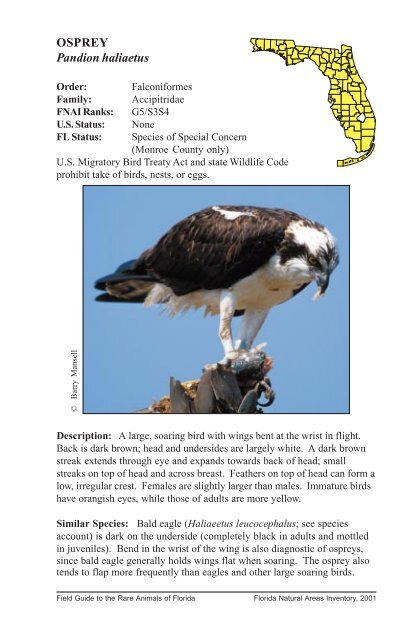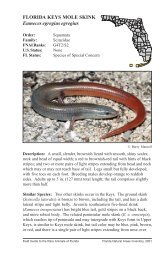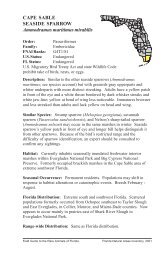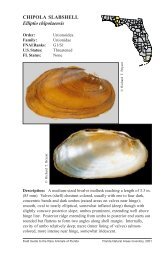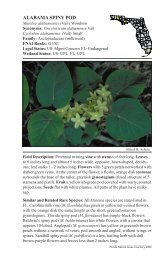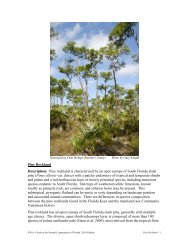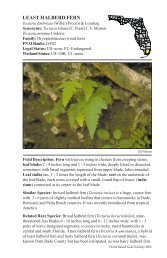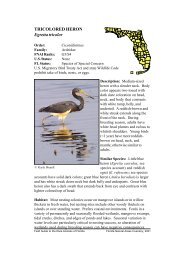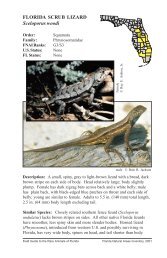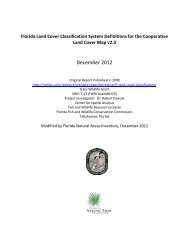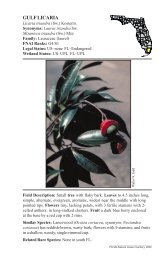OSPREY Pandion haliaetus - FNAI - Florida Natural Areas Inventory
OSPREY Pandion haliaetus - FNAI - Florida Natural Areas Inventory
OSPREY Pandion haliaetus - FNAI - Florida Natural Areas Inventory
Create successful ePaper yourself
Turn your PDF publications into a flip-book with our unique Google optimized e-Paper software.
<strong>OSPREY</strong><br />
<strong>Pandion</strong> <strong>haliaetus</strong><br />
Order:<br />
Family:<br />
<strong>FNAI</strong> Ranks:<br />
U.S. Status:<br />
FL Status:<br />
Falconiformes<br />
Accipitridae<br />
G5/S3S4<br />
None<br />
Species of Special Concern<br />
(Monroe County only)<br />
U.S. Migratory Bird Treaty Act and state Wildlife Code<br />
prohibit take of birds, nests, or eggs.<br />
© Barry Mansell<br />
Description: A large, soaring bird with wings bent at the wrist in flight.<br />
Back is dark brown; head and undersides are largely white. A dark brown<br />
streak extends through eye and expands towards back of head; small<br />
streaks on top of head and across breast. Feathers on top of head can form a<br />
low, irregular crest. Females are slightly larger than males. Immature birds<br />
have orangish eyes, while those of adults are more yellow.<br />
Similar Species: Bald eagle (Haliaeetus leucocephalus; see species<br />
account) is dark on the underside (completely black in adults and mottled<br />
in juveniles). Bend in the wrist of the wing is also diagnostic of ospreys,<br />
since bald eagle generally holds wings flat when soaring. The osprey also<br />
tends to flap more frequently than eagles and other large soaring birds.<br />
Field Guide to the Rare Animals of <strong>Florida</strong> <strong>Florida</strong> <strong>Natural</strong> <strong>Areas</strong> <strong>Inventory</strong>, 2001
<strong>OSPREY</strong><br />
<strong>Pandion</strong> <strong>haliaetus</strong><br />
Habitat: Found on or near large lakes, rivers, and coastal areas where<br />
suitable nesting sites can be found. Water bodies must be large, fairly open,<br />
and clear for osprey to locate prey. Nesting sites are large living or dead<br />
trees and man-made structures; osprey numbers appear to be limited by<br />
presence of adequate nesting sites. Nesting sites often stand above<br />
surrounding vegetation or in more open fields and sparsely timbered<br />
forests, but low nesting sites are common, particularly in mangrove<br />
swamps. Nesting may seem colonial in some coastal areas or surrounding<br />
large inland lakes. Lake Istokpoga in Highlands County supported 229<br />
active nests in 2000.<br />
Seasonal Occurrence: May be found throughout <strong>Florida</strong> in all seasons,<br />
but winter records are less common, particularly in north <strong>Florida</strong>. Numbers<br />
generally increase in north <strong>Florida</strong> beginning with spring migration in<br />
February; fall migration appears to commence in September. Large<br />
numbers may occasionally be seen moving south in fall.<br />
<strong>Florida</strong> Distribution: Found throughout <strong>Florida</strong>, but may be rare in some<br />
areas. The interior of the panhandle has very few nesting birds, and winter<br />
records are even less common. Population may be increasing, however, and<br />
sightings may become more regular at some inland lakes and rivers in the<br />
panhandle.<br />
Range-wide Distribution: Cosmopolitan. Found throughout much of<br />
North America and in many parts of Asia, Australia, Africa, Europe, and<br />
South America. Found throughout Gulf of Mexico, Bahamas, Caribbean,<br />
and the Antilles.<br />
Conservation Status:. Listing as a Species of Special Concern seems to<br />
stem from threats posed to nesting sites in Monroe County, particularly by<br />
boat traffic. Population declines documented in the latter half of the 1900s<br />
probably stemmed from eggshell thinning (caused by organophosphate<br />
pesticides), which was documented at some <strong>Florida</strong> breeding sites. Another<br />
potential cause for declines observed in south <strong>Florida</strong> is lowered food<br />
availability.<br />
Protection and Management: Regulate boat traffic, especially in some<br />
coastal areas where nests are situated low to the water and in good numbers<br />
at close proximity. Populations can be expanded in some areas through<br />
construction of nesting platforms.<br />
Selected References: McMillian 2001, Robertson and Woolfenden 1992,<br />
Rodgers et al. (eds.) 1996, Stevenson and Anderson 1994.<br />
Field Guide to the Rare Animals of <strong>Florida</strong> <strong>Florida</strong> <strong>Natural</strong> <strong>Areas</strong> <strong>Inventory</strong>, 2001


